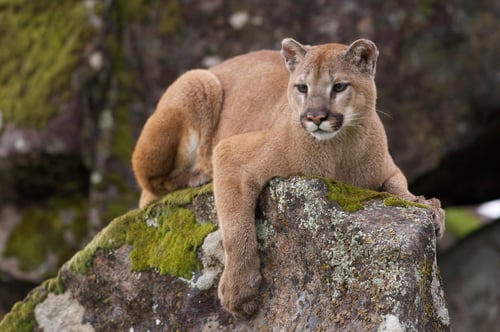As the scorching summer heat takes hold, our bodies activate a remarkable mechanism to cool down—sweating. While humans rely on sweating to regulate our body temperature, the diverse wildlife who live here in the Rocky Mountains have evolved unique adaptations to combat the heat.
Sweating is a vital part of our body's thermoregulatory system, allowing us to maintain a stable internal temperature. We have a high number of sweat glands distributed throughout our skin which produce a fluid comprised of water, electrolytes, and metabolic waste. As the sweat on our skin evaporates it also carries away excess heat. This evaporation process dissipates body heat and cools the skin, helping to regulate our body temperature. Sweating also plays a crucial role in hydration and electrolyte balance. As we sweat, we lose fluids and minerals, emphasizing the importance of proper hydration during hot weather or physical exertion.

Mountain lions are known to rest in shaded areas during the hottest parts of the day.
While humans rely heavily on sweating, other animals have different strategies to beat the heat. Many animals have variations of body size and the size of extremities like ears, tails, legs, and feet. Many animals shed layers of fur and even change color to adapt to seasonal weather patterns. Animals have efficient metabolisms and the ability to thermoregulate by adjusting systems and the insulative fat reserves within their bodies. Just like us, most animals seek shade and water to help them to stay cool.
Members of the canine family, such as dogs, coyotes, and wolves, have very few sweat glands so they rely on panting as their primary cooling mechanism. By rapidly inhaling and exhaling, dogs circulate air over their moist tongues, facilitating evaporation and heat loss from the respiratory system.
Mountain lions and other members of the feline family have adapted to the region's varied climates. They possess large nasal passages that aid in cooling by facilitating efficient air exchange during respiration. Additionally, mountain lions are known to rest in shaded areas during the hottest parts of the day, conserving energy and avoiding excessive heat exposure.
Vultures’ lack of feathers on their heads and necks helps them to stay cool and dissipate heat more effectively. They are able to soar and glide using updrafts and wind currents to stay cool and avoid excess exertion when flying. Vultures use a unique cooling mechanism called urohydrosis, which involves excreting liquid waste onto their legs to take advantage of the evaporative cooling effect.
Found in the alpine meadows and rocky slopes of the Rockies, American pikas avoid overheating by spending their days in cool rock crevices and avoiding direct sunlight. These small mammals also possess a high metabolic rate, allowing them to generate body heat efficiently in colder environments. However, pikas have a low tolerance for temperatures higher than 78 degrees and are not well adapted to the increasing temperatures at high elevations.
Sweating is a remarkable physiological adaptation that helps humans to regulate body temperature efficiently. In the Rocky Mountain region, where temperatures can fluctuate dramatically, various animal species have developed remarkable adaptations to cope with heat stress. Studying these adaptations not only provides a deeper understanding of the intricate relationship between organisms and their environments but also offers valuable insights for human adaptation and conservation strategies in the face of climate change.
Lara Carlson is the Senior Programs Director at Walking Mountains Science Center. Her favorite strategy to cool off during outdoor adventures is resting with her feet in a cold mountain stream.







